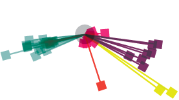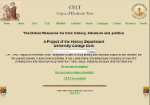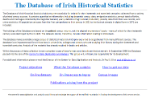1996-1997
An Index of the statistical content of the printed British and Irish census volumes
|
CDDA has received a grant from the British Academy to fund the construction of an index of the statistics contained in printed census volumes for the British Isles. In all there are 19 censuses for Great Britain and 16 for Ireland. From the mid-nineteenth century the printed reports stretch to several volumes and thousands of pages. These volumes provide a rich vein of statistical data on the social and economic makeup of the British Isles. They are not restricted to simple head counts of the population but include information on housing, age and sex structure, occupations, language, religion, health and education. Examination over time allows social and economic change in the British Isles to be described. Increasingly census tables are being computerised and the digital data files deposited with the History Data Service making the material even more accessible. There remains a significant problem in the utilisation of this important resource. Many scholars are simply not aware of the statistical breadth of the censuses. The situation is complex. The printed reports carry a far wider range of quantitative data than simply demographic statistics. The scope of these statistics varies from year to year. For some parts of the United Kingdom individual statistical series were collected, often over several census years, which were never gathered for the remainder of the British Isles. This project, now largely complete, will address these problems though the compilation of a comprehensive on-line index of each and every census table thus allowing scholars to quickly apprise themselves of the scope of these important resources. |
Corpus of Electronic Texts
http://www.ucc.ie/celt/
|
|
CELT, the Corpus of Electronic Texts, is Ireland's longest running Humanities Computing project. It brings the wealth of Irish literary and historical culture to you on the Internet, for the use and benefit of everyone worldwide. It has a searchable online textbase consisting of 17 million words, in 1521 contemporary and historical documents from many areas, including literature and the other arts. LDT (Linking Dictionaries and Texts) is a collaborative project involving the eDIL project in the University of Ulster and CELT in University College Cork. The CELT Project has published a large corpus of SGML-encoded Irish texts on the web, while the eDIL project is producing an electronic version of the Royal Irish Academy’s Dictionary of the Irish Language (DIL). The aim of the LDT project is to link eDIL to CELT’s corpus of on-line texts so that users of eDIL will be able to view in full on the internet texts cited in DIL. This will be extremely valuable to scholars who do not have easy access to a well-stocked research library but will also enable any researcher anywhere in the world to rapidly check the complete context of citations without leaving their desk. Many of the texts cited in DIL are already available on the CELT website, but a major task for the LDT Project will be to capture and publish those texts not already on the site. The Centre for Data Digitisation and Analysis is the data capture and encoding partner in this work. |
SECOS dataset of British and Irish census statistics
|
We worked with Dr David Gatley from the University of Staffordshire and Roger Watson of Statistics for Education between 1999 and 2001 to create a teaching resource based on census data. The project resulted in a series of datasets based on census data from 1801-1871 for use in the SECOS data handling package. |
The Database of Irish Historical Statistics
http://www.qub.ac.uk/cdda/CDDA_2011/iredb/dbhme.htm
|
|
The Database of Irish Historical Statistics holds recurrent statistics for Ireland for the nineteenth and twentieth centuries collected from a variety of printed census sources. It contains quantitative information, including decennial census data, emigration statistics, annual totals of births, deaths and marriages collected by the Registrar General, yearly statistics of agricultural production, poverty data from Poor Law records, and crime statistics. All population censuses from the first comprehensive Irish census in 1821 to the last not already in digital form in 1971 are included. The holdings of the Database are based on the printed census returns, not the original enumerators' books - many of which for the nineteenth century were destroyed by fire in 1922. The datasets do not, therefore, include information relating to individuals. The database makes available a large corpus of statistical material which previously had to be gathered from many different sources. The database is an important tool for all historians in universities, colleges and schools who are studying Irish history during the nineteenth and twentieth centuries. Analysis of the material has already resulted in books and articles. Whilst the process of data collection is now complete issues of data formats and data dissemination remain. In September 1998 the Database passed into the care of the Centre for Data Digitisation and Analysis. This group will, in future, be responsible for its development. For additional information please e-mail the Director of the Centre for Data Digitisation and Analysis, Dr Paul S. Ell at Paul.Ell@qub.ac.uk |



